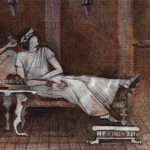In fact, some historians date the origins of organized rheumatology to a spring day in Paris, in April 1925 at the inaugural meeting of the International Society of Medical Hydrology, where Jan van Breeman, MD, a leading Dutch physician, offered a resolution calling for the appointment of an International Committee on Rheumatism. This resolution was the first step in the formation of the American Rheumatism Association (ARA), the forerunner of the ACR.4
The second revolution occurred following the second World War, when, in 1949, before a crowd of a few hundred doctors attending the ARA national meeting, Philip Hench, MD, of the Mayo Clinic, in Rochester, Minn., and his colleagues described the dramatic effects of cortisone in treating RA. Their painstaking research finally identified and isolated the elusive hormonal compound that served as the template for the production of the first corticosteroid drugs. This Nobel Prize-worthy discovery changed our specialty forever. Where would we be without corticosteroids?
The third revolution took place in the latter decades of the 20th century as clinicians gained a clearer understanding of immune-suppressive therapies and initiated more rational approaches to treat rheumatologic diseases that included the use of drugs, such as allopurinol, azathioprine, cyclophosphamide, immune intravenous gammaglobulin, methotrexate, mycophenolate and others, into our armamentarium.
The fourth revolution capitalized on the expanse of knowledge acquired in understanding the pathogenesis of autoimmunity and applied it to create a series of targeted therapeutics that have dramatically transformed our practice. It began with the unraveling of the immune cascade that led to the identification of TNF as a key target in the pathogenesis of inflammation in a host of autoimmune-mediated diseases.5 Subsequent research confirmed the pharmaco-immunologic relevance of several useful targets for commercialization, including interleukin (IL) 1, IL-6, IL-12, IL-17, IL-23, T cell costimulatory receptors, BLyS and CD-20. Rheumatology has moved far beyond our primeval roots in the sauna and the spa.
Our deeper understanding of inflammation’s role in health and disease has created some interesting offshoots. There has been intense interest in utilizing C-reactive protein (C-RP) as a marker for the metabolic syndrome and for cardiovascular disease. This led to the recent observation that canakinumab, a therapeutic monoclonal antibody targeting IL-1β that was developed to treat refractory gout and selected auto-inflammatory disorders, can significantly lower the rate of recurrent cardiovascular events in patients with a previous myocardial infarction and an elevated CRP.6 In a similar vein, the NIH-sponsored Cardiovascular Inflammation Reduction Trial is investigating whether weekly doses of methotrexate can reduce the incidence of cardiovascular events among adults with a history of a prior myocardial infarction and either type II diabetes or the metabolic syndrome.7 When it comes to the affairs of the heart, inflammation matters.
Some historians date the origins of organized rheumatology to a spring day in Paris, in April 1925 at the inaugural meeting of the International Society of Medical Hydrology, where Jan van Breeman, MD, a leading Dutch physician, offered a resolution calling for the appointment of an International Committee on Rheumatism.
Bringing the Bench to the Bedside
The acceleration of extraordinary advances being made in the fields of genomics, bioinformatics and molecular diagnostics defines the fifth revolution in rheumatology. The bench has finally arrived at the bedside. Clinicians and their patients can gain from these breakthroughs. Here is one recent example:

